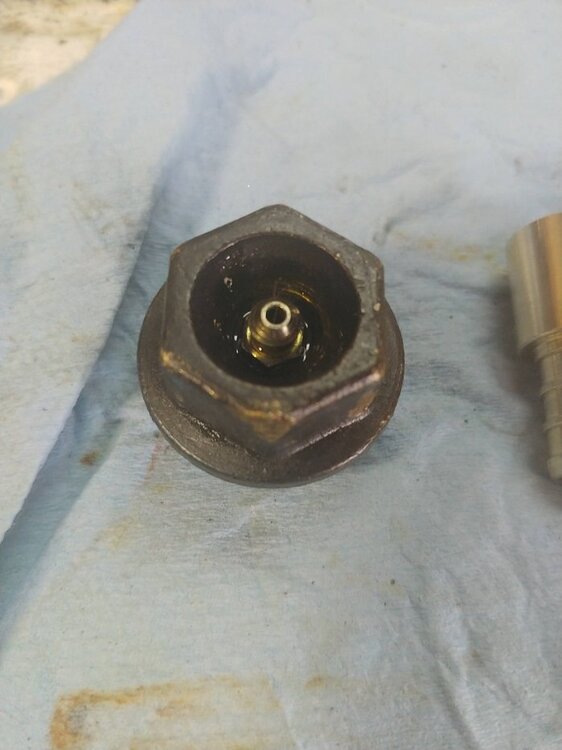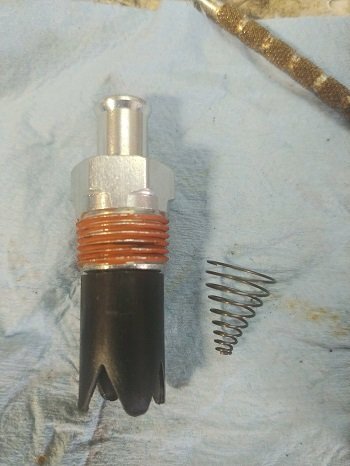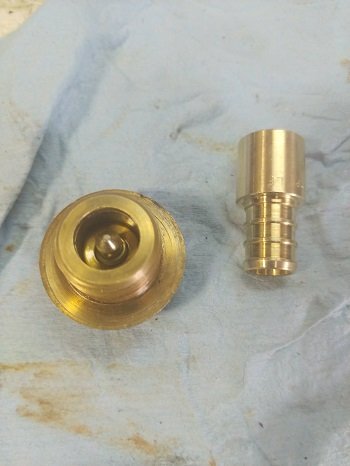-
Posts
1,242 -
Joined
-
Last visited
-
Days Won
43
Content Type
Profiles
Forums
Events
Gallery
Community Map
Everything posted by Pressureangle
-

Another rear drive box vent thread
Pressureangle replied to Pressureangle's topic in Technical Topics
I keep thinking that myself, but given the bashing of parts by the straight cut transmission, I like the idea of the bit of cushion provided. Getting a hose that fits and stays on is a challenge, to be sure. -

Another rear drive box vent thread
Pressureangle replied to Pressureangle's topic in Technical Topics
Oh, and I have to say that the Caruso gears have made a *Yuge* difference in top end running as well as bottom. I have to ask myself if I'm imagining things. In the past, it seemed to take a very long time to get where it would go, indicated about 130. Although I've opened the airbox top since my last WOT speed adventure, 100 came and went so fast at part throttle it's like I sprouted an extra cylinder. We may check that Saturday. -

Another rear drive box vent thread
Pressureangle replied to Pressureangle's topic in Technical Topics
Yes, it's a tiny hole but it only has to pass air as fast as the rear end can heat it. I'll add the hose by Saturday, to keep track of any oil that gets out, keep water out, and hopefully keep the heat cycles from drawing in any meaningful amount of our summer humidity. -

Another rear drive box vent thread
Pressureangle replied to Pressureangle's topic in Technical Topics
Docc, I don't know about the V11 vent system. The 'Sport rear takes 250cc, I used Lucas 80/140 'super duper high performance' gear oil, with about a tablespoon of Jet-Lube open gear and cable grease, which appears to be pure Moly with enough grease to make it stick to stuff-I use that on the spliney stuff. So, after ~20 miles of "3 miles in the middle was 80-100mph" The housing temp was 116*F after 5-6 miles home @ 35mph. But yay, there is no trace of oil at the tip of the bleeder, I didn't even put a hose over it so I could be certain. Saturday I'll go beat it up where I can hold 70-100 for 1-15 miles, and take the temp gun with me. I know y'all have recorded drive temps, what's the norm? 116*F isn't even worth talking about in automotive axles. -

Another rear drive box vent thread
Pressureangle replied to Pressureangle's topic in Technical Topics
Yeah, but this time the *skirt* is brass. -
When I put the bike together a few years ago for my long trip, I went around looking for a reason for, and solution to, gear lube being forced out of the rear drive seal and onto the rim. I ended up drilling a hole in the filler plug and pressing a grease zerk with ball removed into the hole, and running 3-4 feet of tubing up the swingarm and along the frame, exiting by the rear turn signal. In the main it was ok, but at high speeds and unknown distances it still emptied about half the gear oil out of the box over my 10k mile trip. Whilst overlooking my deficits for the 2021 South'n Spine Raid, the tubing disintegrated. So I went looking again. I replaced the zerk with a brake bleeder, tapped and screwed in. The single hole in the bleeder faced forward, away from the flow of lube inside. Way better than the zerk, but still came home after 50 miles with some drool on the wheel, too much to tolerate. So here's my plan. I looked online at axle vents etc, and found one from a jeep with a plastic skirt under it, and a conical spring inside to 'filter' and decant oil back to the axle. I couldn't make it fit under the drive stay rod... but it did give an idea. I stole the spring out of it, went looking for a skirt and found that a brass PEX adapter was a very nice, very tight press into the underside of the fill plug. I wound the spring into the hole and pressed the adapter in with the bench vice, hopefully protecting the bleeder hole from any direct oil splash. Now, on to the testing. Yes, I've considered that it may shake loose. No, I'm confident that it can't-it's tight but not so tight to worry about cracking or splitting while pressing it.
-

Le Mans handlebar end weight: powder coated or standard paint spray?
Pressureangle replied to p6x's topic in Technical Topics
I'd (no I wouldn't myself, actually) chuck it up into my cordless drill and spend a little time smoothing it out, then zinc primer it and final coat with black gloss Rustoleum. Let it dry well in the sun, or oven if you have no sun. It'll be so hard you'll think it's powder coated. -
Yeah, I think from now on I'm just going to use MEK and Acetone after I investigate their tolerance by viton. It's not as convenient but I know it works. I'll use Gumout or CRC for places I have to spray.
-
Asked NAPA for a case of carb cleaner, they came back with about 8 cans of 'Mac's' carb cleaner. Who cares, right? So I'm working on the '89 Mille GT. Had the sump off, tried to clean it with Mac's. No go- simply doesn't cut oil and light, if old, mung. Bleah. Go to the carbs last night, been sitting some time so plenty of varnish. Put all the bits in a cup and make a puddle of Mac's. Doesn't touch the varnish or deposits. Bleah. Then, suddenly, right before my eyes, I watch the o-rings and inlet valve tips expand and disintegrate. Oh, happy day- carb cleaner that doesn't clean anything and destroys carburetor parts in less than 30 seconds. Inlet valve assemblies are $25 each. Just a 'beware'. Don't try to save a penny or a minute using this crap. I returned all of it, not that they cared at all.
-
Good eye, or I'm going senile. I guess I'll have to stock a few.
-
I'll go out on a limb and call this legitimate. I spent time on Omron's website, they do make these but you can only have them if you're an OEM automotive concern- probably at least a tier 1 supplier. So if I was that and could order them, I would, since they have a purchasing requirement but no apparent limitation on subsequent usage. They probably have a minimum order quantity of 500 or something. Oh and West Bloomfield is in the heart of Mopar territory. one last point, it's not 5/$30, it's *each*. bleah
-
My 1100 Sport-i is '97. The only mod when I got it appears to be a FBF crossover pipe. With stock ECU and stock mufflers, it suffered from a relatively mild case of the 'idle stall and 3200rpm blues'. I installed a MyECU in place of the stock controller and tuned it over 10k+ miles to the point where the 3200rpm dip was tolerable and idle stalls were something short of maddening. Very recently (<200 miles) I took out the stock timing chain and wimpy chain tensioner and installed a set of Joe Caruso's cam drive gears, because it 'sounded like' the cam chain was slapping around. And I like jewelry- I could have installed the aftermarket tensioner, which worked as well in my '85 LM1000; nobody was more surprised than I to discover that the idle issues and the 3200rpm dip are *completely gone*. The idle, which I'd probably spent 2 whole man-hours over the time I've owned it getting as good as it could be, suddenly became perfect, stable, 100-150rpm higher; After tuning the mixture and setting the speed, it now idles at 1100rpm and is so steady it's almost ridiculous. I attribute this all to the precision of the trigger wheel, and the inadequate stock chain tensioner creating a bit of confusion in the timing signal at idle and perhaps a resonance at 3200rpm. So my recommendation, if the problem persists after all the obvious and desirable tune-up procedures, is to get rid of the stock timing chain tensioner and install the aftermarket one which is enormously stronger than stock- or if you have the extra gravy, a set of Caruso timing gears. I'd like to have someone else verify that my findings here are what they appear to be.
-
This is actually in Marvic's gallery. Appear to be 18" but it does look effective.
-
I spent a *lot* of research, time, and money on my '85 LM1000. The Web 86b cam is so big I had to change lifters and mill the lifter bores- yet it is far more drivable than the stock camshaft. I milled in perhaps .5 point compression and had the heads ported, but retained the stock Dellorto carbs. It's my studied opinion that the 'brutish feel' of these old hot rods is the 'brick on a stick' camshafts they had, ancient paper designs whereas the modern bikes (and aftermarket cams) have the benefit of computer dynamic modelling of both airflow and valvetrain dynamics, so both power and drivability can be largely determined before the first spark is thrown griding the cam. My '97 1100 Sport-i isn't as smooth, even with the newly installed Caruso gearset- which was an enormous improvement.
-

Banter But Not Silly
Pressureangle replied to Bill Hagan's topic in Special place for banter and conversation
Chanclas are as much a throwing weapon as footwear. Don't you have any Phillipino or Latino neighbors? It's a fine art, and deadly. Just ask any kid. -
FWIW I'm using the Dissenter browser, and I've had less utility issues with it than with Chrome; additionally Dissenter is second to none in privacy. <shrug>
-
I've done all of that, none seems to make a difference.
-
My posts here all originated as copy/paste. I have no idea why it would be different that I did it than someone else.
-
Here is the link to the entire album. https://photos.app.goo.gl/k5dBSEpT7ieyBXFL7
-
I am, and I've used permission links for the pictures, as well as made the album they're in shareable.
-
Yeah, I have a real problem being forced into paying for something that used to be free, and still is elsewhere. What actually interests me is why some people can see the images and others can't.
-
Bring a trailer!











